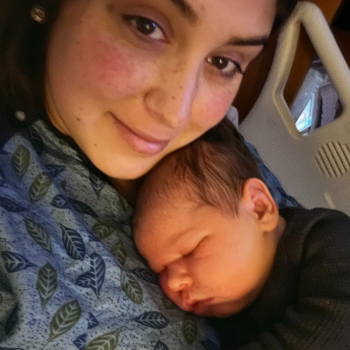Get the latest Preeclampsia Foundation news! Sign up
1742931507.png)
Two Hearts, One Fight: My Journey With Postpartum Preeclampsia and Lily’s Heart Story
March 25, 2025 By Lauren Newcomb
1742931506.png)
| I had a complication-free pregnancy and was induced at 41 weeks. After 36 hours of labor, I pushed for 2.5 hours before Lily Newcomb was born, briefly stuck due to a one-minute shoulder dystocia. I thought the hardest part was behind me, but postpartum preeclampsia turned those early days into a medical emergency. Just one week before my induction, I had read about Olympian Tori Bowie’s passing from preeclampsia. I had never heard of postpartum preeclampsia before then, and even as my blood pressure spiked after delivery, I didn’t realize I was in danger. Just before discharge, my numbers soared, and I was sent back to Labor & Delivery for a 24-hour magnesium drip to prevent seizures. I quickly understood how severe my condition was when the APRNs and midwives rounding on me started mentioning the ICU. I thought I was exhausted from childbirth, not realizing my symptoms were life-threatening. The hospital considered discharging Lily to my husband, Paul, because she was healthy, and they didn’t want us paying insurance costs for a newborn. The thought of being separated so soon after birth was devastating, but we were fortunate she could stay. When I finally left the hospital, my blood pressure was still high at 150/90, and I was prescribed labetalol and nifedipine, which left me dizzy and exhausted. The first month of motherhood was made even harder by my physical recovery and the emotional toll of nearly losing my own life. Just over six weeks later, I was hospitalized again with dangerously high blood pressure while trying to wean off medication. To this day, I remain on a microdose and now have chronic hypertension. No one had warned me this could happen. I received little education on postpartum preeclampsia, despite its severe risks. My experience ignited a passion for maternal health advocacy. Too many mothers don’t know the warning signs until it’s too late. Then, when Lily was 18 months old, we learned she had an atrial septal defect (ASD), a hole in her heart requiring open-heart surgery. On January 29, she underwent surgery at Norton Children’s Hospital. What we feared would be a complex repair turned out to be a straightforward closure without a patch. She recovered in the Jennifer Lawrence Cardiac ICU before moving to the Pediatric Care Unit. Those days in the hospital, watching her tiny body heal, reinforced what I already believed: maternal and infant health are deeply connected. Lily’s surgery was a success, but her heart journey isn’t over. She will continue to see her cardiologist for years to come as she still deals with pulmonary arterial hypertension (PAH). We remain hopeful, but her heart will need lifelong monitoring. Now, my advocacy extends beyond maternal health to congenital heart disease and women’s cardiovascular risks. Preeclampsia increases the risk of heart disease later in life, yet too many mothers are left in the dark. Congenital heart defects, the most common birth defect, remain underfunded. I want better for all mothers and children. I want better for Lily. We continue to weigh the risks of giving Lily a sibling through another pregnancy. It’s hard to forget the chaos and toll of severe postpartum preeclampsia, a long induction, and a shoulder dystocia. Knowing what I know now, the thought of going through it again is daunting. But if I do, I will be armed with knowledge, better questions, and a deep commitment to advocating for myself in a system that too often leaves women unheard. I don’t know what the future holds for our family. But I do know this: I will spend the rest of my life pushing for better education, better research, and better care for women—before, during, and long after pregnancy. Because every mother and baby deserve a fighting chance. |
STORY SPOTLIGHT

My perfect daughter, Katie, gave birth to her first child just eight days before she passed away due to postpartum complications. Her deliver...
ReadMoreLatest Stories
- Olivia & Sean’s Story March 25, 2025
- I Had No Idea March 25, 2025
- My Experience With Preeclampsia and Postpartum Preeclampsia, Which Became A Turning Point In My Life March 17, 2025
- Emergency C Section, Nicu, and Postpartum Preclampsia March 17, 2025
- My Hellp Syndrome Birth Story: Idaho Falls Promise Walk Mission Mom March 06, 2025
- Listen To Your Body March 03, 2025
- Hellp Syndrome and Kidney Failure: Taking Nothing For Granted February 28, 2025
- Surviving Preeclampsia February 28, 2025
- A Survivor’s Story: Twice the Battle, Twice the Victory February 28, 2025
- Postpartum Preeclampsia X2 February 28, 2025
